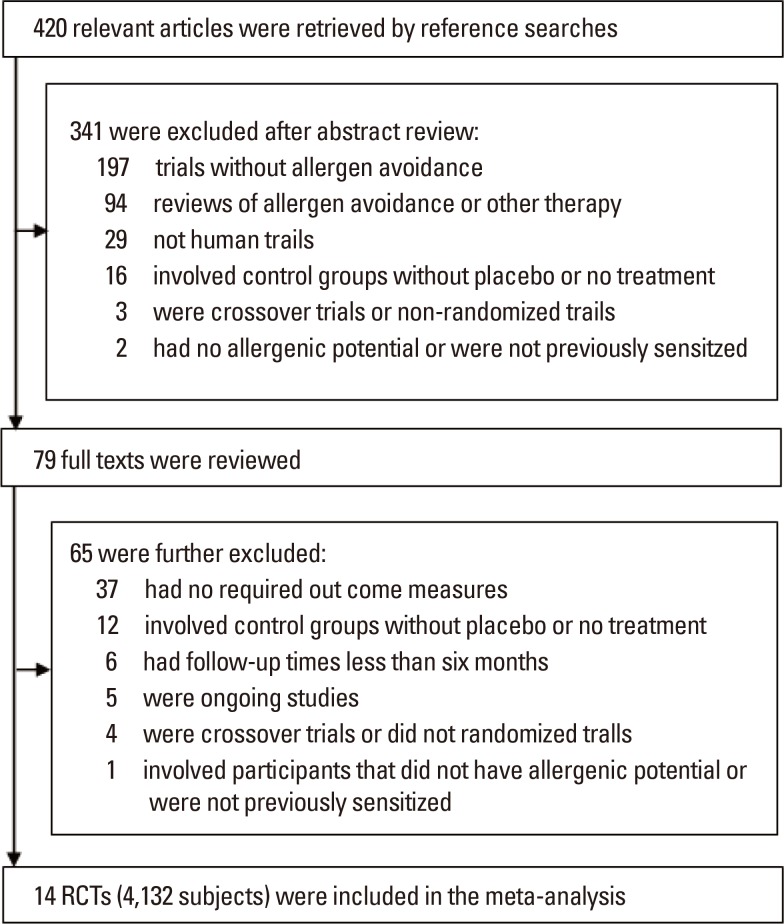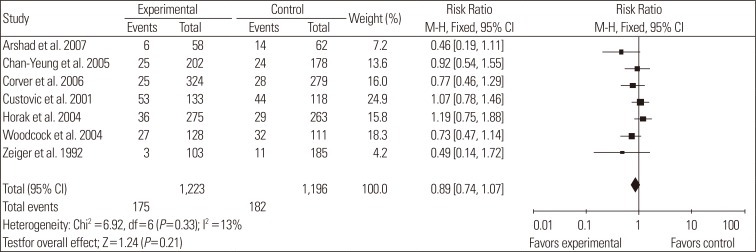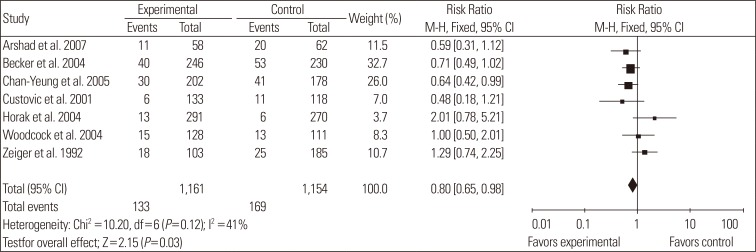Abstract
Purpose
At this time, there is uncertainty regarding whether allergen avoidance is the most appropriate strategy for managing or preventing allergies. The purpose of this study was to evaluate the effectiveness of allergen avoidance in the prevention of allergic symptoms in previously sensitized patients and newborns that have the potential to develop allergies.
Methods
We performed online searches of articles published from January 1980 to December 2012 in PubMed and The Cochrane Central Register of Controlled Trials, and selected articles involving randomized controlled trials (RCTs) and allergen avoidance. The parameters used to determine allergenic potential in newborns included the risk ratio (RR) of eczema, asthma, rhinitis, wheeze, and cough. The methods employed to evaluate previously sensitized patients were the standardized mean difference (SMD) of forced expiratory volume in 1 second (FEV1) and peak expiratory flow rate (PEFR). Data quality was assessed using the Jadad scale.
Results
A total of 14 RCTs were identified. Meta-analysis demonstrated that allergen avoidance for newborns did not reduce the subsequent incidence of allergic diseases (eczema, P=0.21; rhinitis, P=0.3; cough, P=0.1) but significantly reduced the incidence of asthma and wheezing in high-risk infants (asthma, P=0.03; wheeze, P=0.0004). However, previously sensitized patients who reduced their exposure to known allergens did not show improvement in their lung functions (FEV1, P=0.3; PEFR morning, P=0.53; PEFR evening, P=0.2; PEFR, P=0.29).
Conclusions
Allergen avoidance may not always be successful in preventing allergic symptoms. However, rigorous methodological studies are required to confirm this hypothesis.
Keywords: Meta-analysis, allergen avoidance, allergenic potential newborns, previously sensitized patients, allergic diseases
INTRODUCTION
Allergic diseases have been a global health problem that has increased to epidemic proportions in the last few decades.1 Currently available treatments for allergic diseases generally include allergen avoidance, pharmacotherapy, and allergen-specific immunotherapy (SIT). Exposure to allergens contributes to the development of hypersensitivity, and until 2007, many allergy societies advocated allergen avoidance as part of allergy management.2 After a diagnosis of allergic sensitivity has been established based on anamnesis, skin tests, and specific serum IgE antibodies, clinicians generally recommend that their patients avoid future contact with the specific allergen(s). However, allergen avoidance has not decreased the incidence of allergic disorders, but rather an increase in allergies has been observed.3,4 In recent years, several studies have noted the ineffectiveness of allergen intervention in reducing the incidence of allergies. Previous studies have demonstrated that intervention using bed covers impermeable to house dust mite significantly decreases allergen exposure but does not ameliorate the patient's asthma. Furthermore, extended delay in the introduction of foods known to cause allergic reactions actually increased the risk of developing food allergies in infants and children.5,6 In addition, stringent allergen avoidance is not always practical as an allergy treatment; however, desensitization through supervised exposure maybe a better and more feasible therapeutic option.7
Allergen avoidance is commonly used to reduce the incidence and degree of allergic symptoms, but there is still uncertainty and even controversy regarding whether allergen avoidance is the most appropriate strategy for managing or preventing allergies. Thus, to determine whether the practice of allergen avoidance is a reliable and effective method that should continue to be recommended by clinicians for the prevention of allergic symptoms, we analyzed recent randomized controlled trials (RCTs) that applied allergen avoidance to reduce the incidence of allergies.
MATERIALS AND METHODS
Search strategy
Literature searches were conducted for articles published from January 1980 to December 2012 in PubMed and The Cochrane Central Register of Controlled Trials. All databases were searched in English and the MeSH terms included were "allergen avoidance" OR "allergen intervention" OR "allergen abatement" OR "allergen free" (all referred to as "allergen avoidance" hereafter) plus at least one of the following words: "randomized", "controlled", or "blind." After carefully examining the content of the abstracts, we rejected some allergen avoidance trials not relevant to our study. We retrieved the full texts of the preselected abstracts to further assess whether they met our inclusion criteria.
Inclusion criteria
The qualifying studies included the following: (a) limited to human trials, (b) RCTs with allergen avoidance as research subjects, (c) control groups that included a placebo or no interference, (d) newborn participants that had either their parents, siblings or two or more members of their immediate family affected by an allergic disorder, and (e) previously sensitized patients that were diagnosed with allergies by a physician and verified by clinical examination, such as skin testing or serum specific IgE tests.
Exclusion criteria
Studies that contained at least one of the following were excluded: (a) trials that were in combination with other therapies in addition to allergen avoidance, (b) trials that did not report the required outcome measures, (c) trials of presensitized patients that did not have 6 months or more follow-up time, and (d) crossover trials or ongoing clinical trials.
Outcome measures
Trials of newborns with allergenic potential reported the incidence of at least one of the following diseases: (a) asthma, (b) eczema, (c) wheeze, (d) cough, or (e) rhinitis. Trials of presensitized patients included at least one of the following outcome measures: (a) forced expiratory volume in one second (FEV1), (b) peak expiratory flow rate (PEFR), (c) PEFR morning, or (d) PEFR evening.
Data extraction
Studies for analysis were selected by 2 reviewers according to the inclusion/exclusion criteria, and the following essential information was recorded: (a) author, year of publication, (b) participants (sample size, age), (c) intervention and control method, (d) duration, and (e) outcome measures and results. The data extraction process was repeated by 2 additional reviewers.
Trial quality assessment
The methodological quality of meta-analysis was independently assessed by 2 reviewers according to the Jadad scale.8 The scale consisted of 4 items: descriptions of randomization (0-2 points), allocation concealment (0-2 points), blinding (0-2 points), and withdrawals (0-1 points).9,10 The maximum number of points available was 7. Total scores of 4-7 represent high-quality trials, while 0-3 was considered low quality. If the reviewers disagreed on the quality scores, discrepancies were identified and a consensus was reached.
Statistical analysis
Meta-analysis was performed using the Revman 5.0 software from the Cochrane Collaboration. Dichotomous data were calculated as the risk ratios (RR) with 95% confidence intervals (CI). Continuous data were presented as the standardized mean difference (SMD) with 95% CI. The overall effect was represented using Z scores. A P value of <0.05 was considered to indicate statistical significance. Statistical heterogeneity of effect sizes was evaluated by the χ2 and I2 tests. A P value of <0.1 was taken as an indicator of statistically significant heterogeneity using the random-effects model. The fixed-effects model was used for meta-analysis in the absence of significant heterogeneity (P≥0.1). Sensitivity analysis was performed by excluding trials for which the Jadad score was low.
RESULTS
Study descriptions
Of 420 citations selected for broad screening, 79 were considered potentially relevant according to the inclusion criteria after scanning their titles and abstracts. After reviewing the 79 full texts, 65 trials were excluded and 14 trials (4,082 patients)11,12,13,14,15,16,17,18,19,20,21,22,23,24 were selected for meta-analysis (Fig. 1).
Fig. 1.
Flow chart of the trial selection process. A total of 14 randomized controlled trials (RCTs) related to allergen avoidance were included in this study. In total, 4,132 subjects participated in these trials.
All 14 selected articles were RCTs, and 8 pertained to the allergenic potential of infants. Study participants generally followed the environmental allergen intervention protocols in combination with early avoidance of dietary antigens. Six trials enrolled adult allergic patients but did not include any infants. Only studies related to environmental allergens were included. The details of the 14 trials are provided in Tables 1-1 and 1-2.
Table 1-1.
Summary of eight trials of newborns with allergic potential
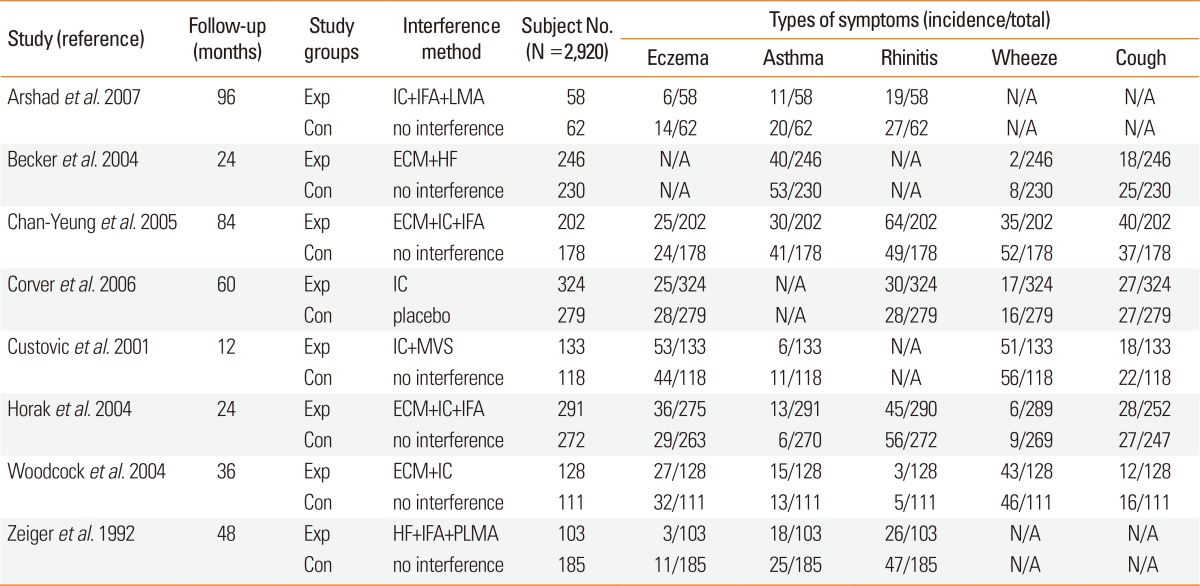
Exp, experimental group; Con, control group; N/A, not available; ECM, environmental control measures including sweeping furniture or bedding regularly or forbidding smoking or removing pets; HF, hydrolyzed formula; IC, impermeable cover; IFA, infant avoidance of hypersensitive food; LMA, maternal avoidance of hypersensitive foods while lactating; MVS, mechanical ventilation systems for accelerating air circulation; PLMA, maternal avoidance of hypersensitive foods during pregnancy and while lactating.
Table 1-2.
Summary of 6 trials of previously sensitized patients
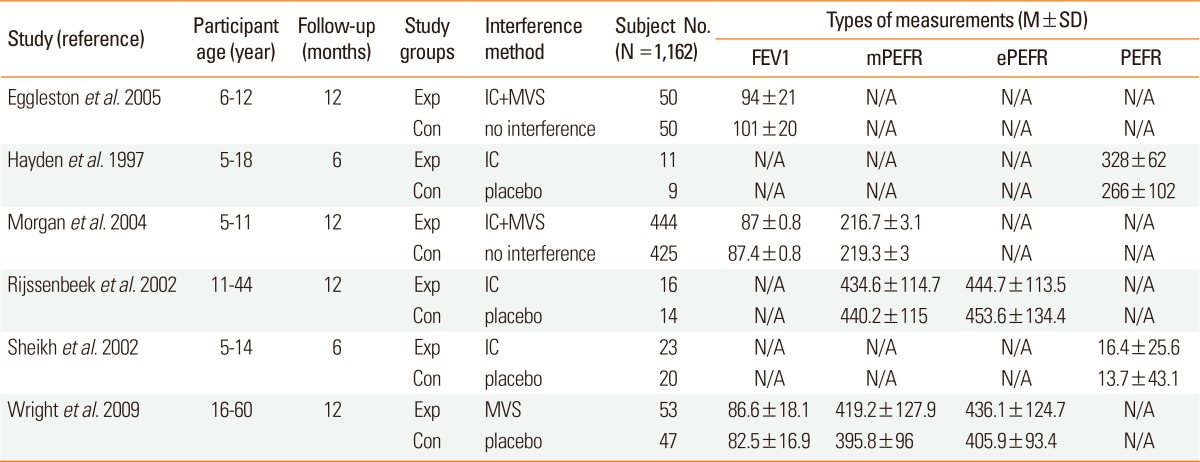
FEV1, forced expiratory volume in one second; mPEFR, peak expiratory flow rate in the morning; ePEFR, peak expiratory flow rate in the evening; PEFR, peak expiratory flow rate; Con, control group; Exp, experimental group; IC, impermeable cover; MVS, mechanical ventilation systems for accelerating air circulation; N/A, not available.
Data quality
Assessment of the data quality of the 14 trials is summarized in Table 2. All studies provided the number of patients who withdrew from the trials. Nine studies (64%) achieved or exceeded a Jadad score of 4 and were considered high quality. All eligible trials claimed to have randomly distributed subjects into the experiment and control groups; however, a substantial number of trials did not provide clear randomization or adequate concealment. Only one (7%) of the trials reported adequate double-blinded results because some allergen control measures are not possible to blind.
Table 2.
Quality assessment of trials included in the meta-analysis
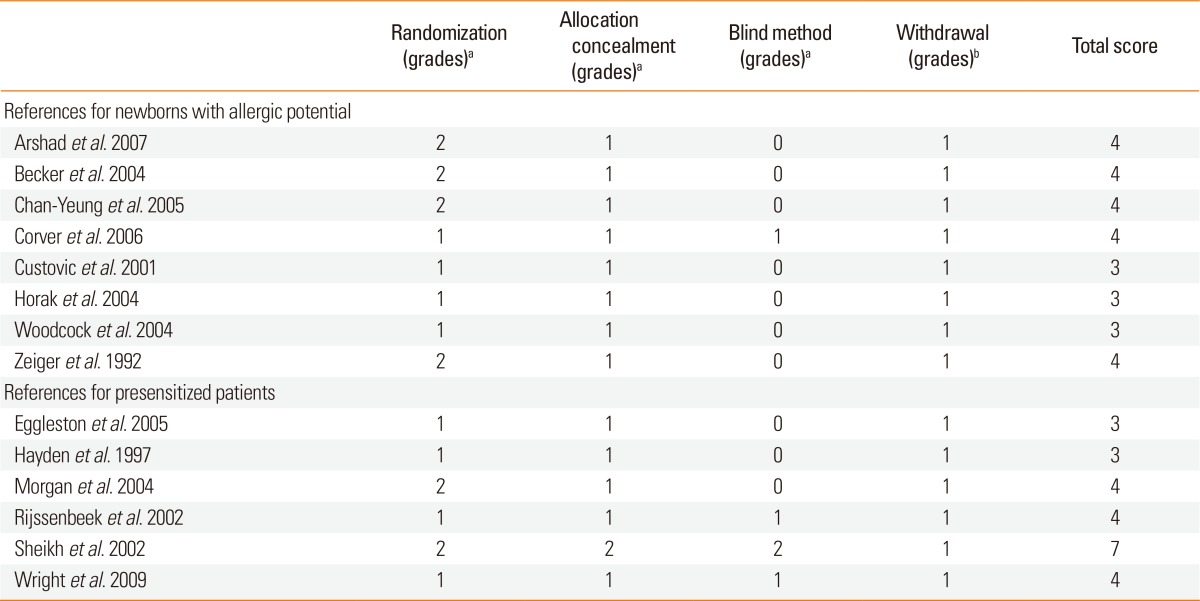
aScoring criteria of randomization/allocation concealment/blind method: 2=adequate with correct procedures; 1=unclear or without a description of methods; 0=inadequate procedures, methods, or information.
bScoring criteria of withdrawal: 1=description of withdrawal reason and number; 0=unknown reason for withdrawal.
Effects of interventions
The fixed-effect models were also utilized for the analysis of eczema (χ2=6.92, df=6, P=0.33) (Fig. 2), rhinitis (χ2=4.66, df=5, P=0.46) (Fig. 3), and cough (χ2=2.27, df=5, P=0.81) (Fig. 4). Overall analysis of these 3 symptoms demonstrated that allergen avoidance, including reduction of exposure to environment allergens and early dietary antigen avoidance, did not reduce the risk of infants for the development of eczema (RR=0.89, 95% CI=0.74-1.07; Z=1.24, P=0.21) (Fig. 2), rhinitis (RR=0.91, 95% CI=0.77-1.09; Z=1.03, P=0.30) (Fig. 3), or cough (RR=0.84, 95% CI=0.68-1.04; Z=1.64, P=0.10) (Fig. 4). Similarly, no obvious heterogeneity was observed in the analysis of asthma (χ2=10.20, df=6, P=0.12) (Fig. 5) and wheezing (χ2=4.71, df=5, P=0.45) (Fig. 6), supporting the use of a fixed-effects model. The result of the overall analysis of asthma and wheezing was opposite to that of eczema, rhinitis, and cough, and demonstrated that allergen avoidance significantly reduced the incidence of asthma and wheezing in high-risk infants (asthma RR=0.8, 95% CI=0.65-0.98, Z=2.15, P=0.03; wheezing RR=0.73, 95% CI=0.61-0.87, Z=3.51, P=0.0004).
Fig. 2.
Forest plot showing the risk ratio for the incidence of eczema comparing allergen avoidance to the control in newborns with the potential to develop allergies. There was no significant difference between the experimental and control groups (P=0.21). Allergen avoidance did not improve the prevalence of eczema in high-risk infants.
Fig. 3.
Forest plot showing the risk ratio for the incidence of rhinitis comparing allergen avoidance to the control in newborns with the potential to develop allergies. There was no significant difference between the experimental and control groups (P=0.30). Allergen avoidance did not improve the prevalence of rhinitis in high-risk infants.
Fig. 4.
Forest plot showing the risk ratio for the incidence of cough comparing allergen avoidance to the control in newborns with the potential to develop allergies. There was no significant difference between the experimental and control groups, demonstrating that allergen avoidance had no effect on the development of cough in infants with allergenic potential (P=0.10).
Fig. 5.
Forest plot showing the risk ratio for the incidence of asthma comparing allergen avoidance to the control in newborns with the potential to develop allergies. There was a significant difference between the experimental and control groups (P=0.03), indicating the effectiveness of allergen avoidance in high-risk infants.
Fig. 6.
Forest plot showing the risk ratio for the incidence of wheezing comparing allergen avoidance to control in newborns with the potential to develop allergies. Similar to the above asthma analyses, the overall analysis of the prevalence of wheezing in the experimental group when compared to control infants showed a significant improvement (P=0.0004).
The results of stratified analysis of several other parameters of lung functions are provided in Table 3. The results of FEV1 from the random-effects model analysis were similar in the experimental and control groups. There was obvious heterogeneity in the analysis of PEFR and PEFR evening; therefore, a fixed-effects model was used for the analysis of these parameters, but because the PEFR morning analysis did not show heterogeneity, a random-effects model was used in this case. Stratified analysis based on the FEV1 and PEFR data (including morning and evening) suggested no protective effect of environmental allergen avoidance on previously sensitized patients (Table 4), which contradicted the results of asthma and wheezing.
Table 3.
Stratified analysis of lung function parameters

SMD, standardized mean difference; CI, confidence interval; FEV1, forced expiratory volume in one second; mPEFR, peak expiratory flow rate in the morning; ePERF, peak expiratory flow rate in the evening; PEFR, peak expiratory flow rate.
Table 4.
Sensitivity analysis

Sensitivity analysis was performed by removing low-quality trials, which were defined by having a total Jadad score <4. A P value <0.05 was considered as a statistically significant in the overall analysis. A Heterogeneity (P) value <0.1 was considered an indicator of statistically significant heterogeneity. After removing the low-quality trials, all adjusted results were the same as those found in the overall analysis of previously unadjusted trials.
aData regarding the peak expiratory flow rate in the morning (mPEFR) and peak expiratory flow rate in the evening (ePEFR) were not part of any low quality trial, and hence were not included in the sensitivity analysis.
bAfter removing a low quality trial, PEFR data were obtained from only one RCT, so the heterogeneity (P) was not applicable.
RCTs, randomized controlled trials; RR, risk ratio; SMD, standardized mean difference; CI, confidence interval; FEV1, forced expiratory volume in one second; mPEFR, peak expiratory flow rate in the morning; ePERF, peak expiratory flow rate in the evening; PEFR, peak expiratory flow rate.
Sensitivity analysis
Since inclusion of suboptimal trials could degrade the meta-analysis, sensitivity analysis is commonly performed by excluding the suboptimal trials (such as those of low quality or with small sample sizes) to determine whether the same conclusion could be drawn, thus determining the reliability of meta-analysis. If the results from the adjusted meta-analysis are in accordance with those of the unadjusted meta-analysis, the results of the meta-analysis can be considered reliable. In this study, compared with the unadjusted analysis, identical heterogeneity statuses were indicated by the analyses adjusted by removing trials with Jadad scores of less than 4 (eczema: P=0.53, asthma: P=0.18; rhinitis: P=0.51; wheezing: P=0.23; cough: P=0.62; FEV1: P=0.0006). Thus, the same effects models were applied for the adjusted analyses. The sensitivity analysis results indicated that allergen avoidance did not improve the risk of infants for the development of eczema (P=0.06), rhinitis (P=0.94), or cough (P=0.24), but could reduce the incidence of asthma and wheezing in high-risk infants (asthma, P=0.01; wheezing, P=0.0004.), which was in agreement with the overall analysis of unadjusted trials (Table 4).
DISCUSSION
It is generally believed that allergen avoidance reduces the risk of-or prevents-allergic reactions and that greater allergen exposure increases the immune response. However, recent arguments challenge the effectiveness of this avoidance practice. To date, there has been no clear understanding of whether allergen avoidance alleviates or prevents the symptoms of allergies. Relevant reviews and guidelines do not acknowledge the fact that measures designed to reduce patient exposure to allergen(s) are ineffective, probably because these recommendations were not based on the results of RCTs.
Current analysis using the broader MeSH terms "allergen avoidance" or "allergen intervention" or "allergen abatement" or "allergen free" may allow inclusion of more allergen avoidance-related trials, which may account for multiple allergen interference approaches and allergy symptoms and improve the reliability and credibility of meta-analysis. However, we are not certain whether all relevant RCTs were retrieved in our search if the eligible trials did not use the above key words in their reports.
At this time, allergen avoidance can be classified into either the reduction of exposure to environmental allergens or avoidance of dietary antigens. Environmental allergen exposure reduction commonly pertains to the avoidance of indoor allergens, including the removal of pets, use of air filtration and vacuum cleaners, use of allergen-impermeable mattress and pillow covers, cockroach extermination, and measures to control mold growth in the home. Because patients sensitized to food allergens who are required to restrict their diets cannot be recruited into RCTs, dietary antigen avoidance in this analysis applies only to newborns and their mothers. Pregnant or lactating mothers followed a strict dietary regimen and/or used hydrolyzed formula instead of milk/breast-feeding.
Some trials recorded allergen (i.e., cat dander, mite) counts by collecting allergen samples from the home or workplace. However, decreases in allergen concentrations at sampled sites did not always correspond to a similar reduction in the participant's exposure. Moreover, even very low allergen levels can lead to bronchial responsiveness.25 Therefore, we did not consider allergen concentrations in the evaluation of the efficacy of allergen avoidance.
The practice of reducing exposure to environmental allergens did protect patients with moderate-to-severe asthma against increased allergen sensitivity when they were evaluated after 1 month, but asthmatic symptoms had recurred by the time these patients were reviewed after 12 months.20,26 Thus, environmental allergen avoidance for a short duration may lead to an increased rate of false positive results. In general, allergen interference of more than 6 months did not alleviate patient symptoms.5,27,28,29 Therefore, only RCTs of previously sensitized patients who were followed up for 6 months or more were selected for meta-analysis in this study.
Although some trials included in this study were graded moderately, sensitivity analysis supported the reliability of our results. Nevertheless, factors, such as incomplete randomization, the absence of blinding, or inadequate allocation concealment, may pose a risk of potential bias in this analysis.
Data from the analyzed RCTs showed that the practice of allergen avoidance did not achieve a statistically significant reduction in the symptoms of allergic diseases, including eczema, cough, or rhinitis in high-risk infants. Moreover, even after 2 years of intervention, the incidence of eczema, rhinitis, and cough did not decrease. While the meta-analysis revealed that practicing allergen avoidance did not reduce the risk of eczema, rhinitis, or cough in high-risk infants, it did reduce the risk of asthma and wheezing. It is worth noting that dietary antigen avoidance may have an adverse effect on maternal and fetal nutritional status by restricting the consumption of foods, such as eggs, milk and nuts, which are sources of important nutrients.30
Previously sensitized patients enrolled in the trials were asthmatics and were sensitized most frequently to house mites. FEV1 and PEFR (including morning and evening) are the most common parameters used for evaluating the severity of asthma.31 Asthma is a chronic condition characterized by ongoing inflammation of the airways. Therefore, the elimination of allergens should reduce inflammation and improve the symptoms of asthmatic patients. However, some asthmatic patients who were able to reduce their allergen (mite) exposure did not experience a positive effect. It is necessary to mention that mite-sensitized asthmatic patients are often cross-reactive to other allergens, such as food allergens, thus complicating achievement of a reduction in exposure to all allergens.32,33
Considering that patients are unwilling to risk eating foods that they have allergies towards, performance of RCTs with food allergens is problematic. Additionally, cross-sensitization invalidates attempts to avoid all allergens. Some studies have demonstrated that pollen-sensitized patients frequently present allergic symptoms after ingestion of several types of plant-derived food34,35,36 or after exposure to other inhaled pollens.37 The phylogenetic relationships between organisms are the cause of cross-sensitization; certain allergens are common to a variety of species and a high degree of homology in the primary antigenic structure can contribute to a loss of efficacy of allergen avoidance in terms of preventing allergic symptoms.
Strict allergen avoidance is not always suitable for treatment due to difficulties in implementation. Patients must learn how to avoid cross-reactive and/or cross-contaminated allergens. Product labels can facilitate identification of known allergens, but some individuals cannot understand complex lists of ingredients, let alone unlabeled products. The lack of information regarding food allergens also restricts the avoidance process.38 Avoidance of airborne allergens is even more difficult. As Morris Ling has reported,39 adequate allergen avoidance is difficult because of the physical characteristics of airborne animal allergens and patient noncompliance. Low levels of indoor allergens may be achieved through reliable house cleaning, but outdoor pollens as well as molds are impossible to avoid completely. This might explain why lung functions of asthmatic patients, referenced by FEV1 and PEFR data (including morning and evening), showed no improvement after environmental allergen avoidance.
The rationale for practicing allergen avoidance is based on the assumption that exposure could result in dangerous or unpleasant allergic reactions and avoidance may prevent or accelerate recovery from allergic symptoms. However, this assumption does not agree with the "hygiene hypothesis."39,40 This hypothesis states that a lack of early childhood exposure to infectious agents, symbiotic microorganisms, and parasites increases susceptibility to allergic diseases by suppressing the natural development of the immune system. Many studies have expanded this hypothesis to non-infectious agents. For example, a previous study confirmed that food-allergic children on an elimination diet developed dysregulation of their Th1 and Th2 responses after exposure to food allergens.41 Another study suggested that early consumption of peanuts in infancy, rather than avoidance, will prevent peanut allergy.7
In conclusion, this study demonstrates that allergen avoidance aimed at reducing allergic sensitization is not always successful and may not be a suitable for the majority of patients. The diverse views on the practice of allergen avoidance may provide novel therapeutic perspectives in the prevention of allergic diseases. However, more rigorous methodological studies are required.
ACKNOWLEDGMENTS
We thank Lucinda Beck for her editing and critical review of the manuscript. This work was supported by the National Science and Technology Major Project of China (2011ZX08011-005), the Special Clinical Research Fund from Wu JiePing Medical Foundation (320.6750.1284), and the program for Guangzhou Municipal Innovation Team of Education & Scientific Research (No. B94118). The funders had no role in study design, data collection and analysis, decision to publish, or preparation of the manuscript.
Footnotes
There are no financial or other issues that might lead to conflict of interest.
References
- 1.Ring J, Akdis C, Behrendt H, Lauener RP, Schäppi G, Akdis M, Ammann W, de Beaumont O, Bieber T, Bienenstock J, Blaser K, Bochner B, Bousquet J, Crameri R, Custovic A, Czerkinsky C, Darsow U, Denburg J, Drazen J, de Villiers EM, Fire A, Galli S, Haahtela T, zur Hausen H, Hildemann S, Holgate S, Holt P, Jakob T, Jung A, Kemeny M, Koren H, Leung D, Lockey R, Marone G, Mempel M, Menné B, Menz G, Mueller U, von Mutius E, Ollert M, O'Mahony L, Pawankar R, Renz H, Platts-Mills T, Roduit C, Schmidt-Weber C, Traidl-Hoffmann C, Wahn U, Rietschel E. Davos declaration: allergy as a global problem. Allergy. 2012;67:141–143. doi: 10.1111/j.1398-9995.2011.02770.x. [DOI] [PubMed] [Google Scholar]
- 2.Prescott SL, Bouygue GR, Videky D, Fiocchi A. Avoidance or exposure to foods in prevention and treatment of food allergy? Curr Opin Allergy Clin Immunol. 2010;10:258–266. doi: 10.1097/ACI.0b013e328339ab25. [DOI] [PubMed] [Google Scholar]
- 3.Eder W, Ege MJ, von Mutius E. The asthma epidemic. N Engl J Med. 2006;355:2226–2235. doi: 10.1056/NEJMra054308. [DOI] [PubMed] [Google Scholar]
- 4.Bieber T. Atopic dermatitis. N Engl J Med. 2008;358:1483–1494. doi: 10.1056/NEJMra074081. [DOI] [PubMed] [Google Scholar]
- 5.de Vries MP, van den Bemt L, Aretz K, Thoonen BP, Muris JW, Kester AD, Cloosterman S, van Schayck CP. House dust mite allergen avoidance and self-management in allergic patients with asthma: randomised controlled trial. Br J Gen Pract. 2007;57:184–190. [PMC free article] [PubMed] [Google Scholar]
- 6.Flinterman AE, Knulst AC, Meijer Y, Bruijnzeel-Koomen CA, Pasmans SG. Acute allergic reactions in children with AEDS after prolonged cow's milk elimination diets. Allergy. 2006;61:370–374. doi: 10.1111/j.1398-9995.2006.01018.x. [DOI] [PubMed] [Google Scholar]
- 7.Du Toit G, Katz Y, Sasieni P, Mesher D, Maleki SJ, Fisher HR, Fox AT, Turcanu V, Amir T, Zadik-Mnuhin G, Cohen A, Livne I, Lack G. Early consumption of peanuts in infancy is associated with a low prevalence of peanut allergy. J Allergy Clin Immunol. 2008;122:984–991. doi: 10.1016/j.jaci.2008.08.039. [DOI] [PubMed] [Google Scholar]
- 8.Jadad AR, Moore RA, Carroll D, Jenkinson C, Reynolds DJ, Gavaghan DJ, McQuay HJ. Assessing the quality of reports of randomized clinical trials: is blinding necessary? Control Clin Trials. 1996;17:1–12. doi: 10.1016/0197-2456(95)00134-4. [DOI] [PubMed] [Google Scholar]
- 9.Schachter HM, Pham B, King J, Langford S, Moher D. How efficacious and safe is short-acting methylphenidate for the treatment of attention-deficit disorder in children and adolescents? A meta-analysis. CMAJ. 2001;165:1475–1488. [PMC free article] [PubMed] [Google Scholar]
- 10.Schulz KF, Chalmers I, Hayes RJ, Altman DG. Empirical evidence of bias. Dimensions of methodological quality associated with estimates of treatment effects in controlled trials. JAMA. 1995;273:408–412. doi: 10.1001/jama.273.5.408. [DOI] [PubMed] [Google Scholar]
- 11.Arshad SH, Bateman B, Sadeghnejad A, Gant C, Matthews SM. Prevention of allergic disease during childhood by allergen avoidance: the Isle of Wight prevention study. J Allergy Clin Immunol. 2007;119:307–313. doi: 10.1016/j.jaci.2006.12.621. [DOI] [PubMed] [Google Scholar]
- 12.Becker A, Watson W, Ferguson A, Dimich-Ward H, Chan-Yeung M. The Canadian asthma primary prevention study: outcomes at 2 years of age. J Allergy Clin Immunol. 2004;113:650–656. doi: 10.1016/j.jaci.2004.01.754. [DOI] [PubMed] [Google Scholar]
- 13.Chan-Yeung M, Ferguson A, Watson W, Dimich-Ward H, Rousseau R, Lilley M, Dybuncio A, Becker A. The Canadian Childhood Asthma Primary Prevention Study: outcomes at 7 years of age. J Allergy Clin Immunol. 2005;116:49–55. doi: 10.1016/j.jaci.2005.03.029. [DOI] [PubMed] [Google Scholar]
- 14.Corver K, Kerkhof M, Brussee JE, Brunekreef B, van Strien RT, Vos AP, Smit HA, Gerritsen J, Neijens HJ, de Jongste JC. House dust mite allergen reduction and allergy at 4 yr: follow up of the PIAMA-study. Pediatr Allergy Immunol. 2006;17:329–336. doi: 10.1111/j.1399-3038.2006.00410.x. [DOI] [PubMed] [Google Scholar]
- 15.Custovic A, Simpson BM, Simpson A, Kissen P, Woodcock A NAC Manchester Asthma and Allergy Study Group. Effect of environmental manipulation in pregnancy and early life on respiratory symptoms and atopy during first year of life: a randomised trial. Lancet. 2001;358:188–193. doi: 10.1016/S0140-6736(01)05406-X. [DOI] [PubMed] [Google Scholar]
- 16.Eggleston PA, Butz A, Rand C, Curtin-Brosnan J, Kanchanaraksa S, Swartz L, Breysse P, Buckley T, Diette G, Merriman B, Krishnan JA. Home environmental intervention in inner-city asthma: a randomized controlled clinical trial. Ann Allergy Asthma Immunol. 2005;95:518–524. doi: 10.1016/S1081-1206(10)61012-5. [DOI] [PubMed] [Google Scholar]
- 17.Hayden ML, Perzanowski M, Matheson L, Scott P, Call RS, Platts-Mills TA. Dust mite allergen avoidance in the treatment of hospitalized children with asthma. Ann Allergy Asthma Immunol. 1997;79:437–442. doi: 10.1016/S1081-1206(10)63040-2. [DOI] [PubMed] [Google Scholar]
- 18.Horak F, Jr, Matthews S, Ihorst G, Arshad SH, Frischer T, Kuehr J, Schwieger A, Forster J SPACE study group. Effect of mite-impermeable mattress encasings and an educational package on the development of allergies in a multinational randomized, controlled birth-cohort study -- 24 months results of the Study of Prevention of Allergy in Children in Europe. Clin Exp Allergy. 2004;34:1220–1225. doi: 10.1111/j.1365-2222.2004.02024.x. [DOI] [PubMed] [Google Scholar]
- 19.Morgan WJ, Crain EF, Gruchalla RS, O'Connor GT, Kattan M, Evans R, 3rd, Stout J, Malindzak G, Smartt E, Plaut M, Walter M, Vaughn B, Mitchell H Inner-City Asthma Study Group. Results of a home-based environmental intervention among urban children with asthma. N Engl J Med. 2004;351:1068–1080. doi: 10.1056/NEJMoa032097. [DOI] [PubMed] [Google Scholar]
- 20.Rijssenbeek-Nouwens LH, Oosting AJ, de Bruin-Weller MS, Bregman I, de Monchy JG, Postma DS. Clinical evaluation of the effect of anti-allergic mattress covers in patients with moderate to severe asthma and house dust mite allergy: a randomised double blind placebo controlled study. Thorax. 2002;57:784–790. doi: 10.1136/thorax.57.9.784. [DOI] [PMC free article] [PubMed] [Google Scholar]
- 21.Sheikh A, Hurwitz B, Sibbald B, Barnes G, Howe M, Durham S. House dust mite barrier bedding for childhood asthma: randomised placebo controlled trial in primary care [ISRCTN 63308372] BMC Fam Pract. 2002;3:12. doi: 10.1186/1471-2296-3-12. [DOI] [PMC free article] [PubMed] [Google Scholar]
- 22.Woodcock A, Lowe LA, Murray CS, Simpson BM, Pipis SD, Kissen P, Simpson A, Custovic A NAC Manchester Asthma and Allergy Study Group. Early life environmental control: effect on symptoms, sensitization, and lung function at age 3 years. Am J Respir Crit Care Med. 2004;170:433–439. doi: 10.1164/rccm.200401-083OC. [DOI] [PubMed] [Google Scholar]
- 23.Wright GR, Howieson S, McSharry C, McMahon AD, Chaudhuri R, Thompson J, Donnelly I, Brooks RG, Lawson A, Jolly L, McAlpine L, King EM, Chapman MD, Wood S, Thomson NC. Effect of improved home ventilation on asthma control and house dust mite allergen levels. Allergy. 2009;64:1671–1680. doi: 10.1111/j.1398-9995.2009.02098.x. [DOI] [PubMed] [Google Scholar]
- 24.Zeiger RS, Heller S, Mellon MH, Halsey JF, Hamburger RN, Sampson HA. Genetic and environmental factors affecting the development of atopy through age 4 in children of atopic parents: a prospective randomized study of food allergen avoidance. Pediatr Allergy Immunol. 2007;3:110–127. [Google Scholar]
- 25.Ihre E, Zetterström O. Increase in non-specific bronchial responsiveness after repeated inhalation of low doses of allergen. Clin Exp Allergy. 1993;23:298–305. doi: 10.1111/j.1365-2222.1993.tb00326.x. [DOI] [PubMed] [Google Scholar]
- 26.Rijssenbeek-Nouwens LH, Oosting AJ, De Monchy JG, Bregman I, Postma DS, De Bruin-Weller MS. The effect of anti-allergic mattress encasings on house dust mite-induced early- and late-airway reactions in asthmatic patients. A double-blind, placebo-controlled study. Clin Exp Allergy. 2002;32:117–125. doi: 10.1046/j.0022-0477.2001.01256.x. [DOI] [PubMed] [Google Scholar]
- 27.Luczynska C, Tredwell E, Smeeton N, Burney P. A randomized controlled trial of mite allergen-impermeable bed covers in adult mite-sensitized asthmatics. Clin Exp Allergy. 2003;33:1648–1653. doi: 10.1111/j.1365-2222.2003.01729.x. [DOI] [PubMed] [Google Scholar]
- 28.Marks GB, Tovey ER, Green W, Shearer M, Salome CM, Woolcock AJ. House dust mite allergen avoidance: a randomized controlled trial of surface chemical treatment and encasement of bedding. Clin Exp Allergy. 1994;24:1078–1083. doi: 10.1111/j.1365-2222.1994.tb02746.x. [DOI] [PubMed] [Google Scholar]
- 29.Woodcock A, Forster L, Matthews E, Martin J, Letley L, Vickers M, Britton J, Strachan D, Howarth P, Altmann D, Frost C, Custovic A Medical Research Council General Practice Research Framework. Control of exposure to mite allergen and allergen-impermeable bed covers for adults with asthma. N Engl J Med. 2003;349:225–236. doi: 10.1056/NEJMoa023175. [DOI] [PubMed] [Google Scholar]
- 30.Jennings S, Prescott SL. Early dietary exposures and feeding practices: role in pathogenesis and prevention of allergic disease? Postgrad Med J. 2010;86:94–99. doi: 10.1136/pgmj.2009.086892. [DOI] [PubMed] [Google Scholar]
- 31.Gøtzsche PC, Johansen HK, Schmidt LM, Burr ML. House dust mite control measures for asthma. Cochrane Database Syst Rev. 2004:CD001187. doi: 10.1002/14651858.CD001187.pub2. [DOI] [PubMed] [Google Scholar]
- 32.Liao EC, Lee MF, Tsaii JJ. The tropmyosin specific IgE and its roles of cross-reactivity between shrimp and dust mites. Clin Transl Allergy. 2011;1:P70. [Google Scholar]
- 33.Wang J, Calatroni A, Visness CM, Sampson HA. Correlation of specific IgE to shrimp with cockroach and dust mite exposure and sensitization in an inner-city population. J Allergy Clin Immunol. 2011;128:834–837. doi: 10.1016/j.jaci.2011.07.045. [DOI] [PMC free article] [PubMed] [Google Scholar]
- 34.Fernández-Rivas M, Bolhaar S, González-Mancebo E, Asero R, van Leeuwen A, Bohle B, Ma Y, Ebner C, Rigby N, Sancho AI, Miles S, Zuidmeer L, Knulst A, Breiteneder H, Mills C, Hoffmann-Sommergruber K, van Ree R. Apple allergy across Europe: how allergen sensitization profiles determine the clinical expression of allergies to plant foods. J Allergy Clin Immunol. 2006;118:481–488. doi: 10.1016/j.jaci.2006.05.012. [DOI] [PubMed] [Google Scholar]
- 35.Vieths S, Scheurer S, Ballmer-Weber B. Current understanding of cross-reactivity of food allergens and pollen. Ann N Y Acad Sci. 2002;964:47–68. doi: 10.1111/j.1749-6632.2002.tb04132.x. [DOI] [PubMed] [Google Scholar]
- 36.Scheurer S, Wangorsch A, Haustein D, Vieths S. Cloning of the minor allergen Api g 4 profilin from celery (Apium graveolens) and its cross-reactivity with birch pollen profilin Bet v 2. Clin Exp Allergy. 2000;30:962–971. doi: 10.1046/j.1365-2222.2000.00821.x. [DOI] [PubMed] [Google Scholar]
- 37.Davies JM, Dang TD, Voskamp A, Drew AC, Biondo M, Phung M, Upham JW, Rolland JM, O'Hehir RE. Functional immunoglobulin E cross-reactivity between Pas n 1 of Bahia grass pollen and other group 1 grass pollen allergens. Clin Exp Allergy. 2011;41:281–291. doi: 10.1111/j.1365-2222.2010.03670.x. [DOI] [PubMed] [Google Scholar]
- 38.Kim JS, Sicherer SH. Living with food allergy: allergen avoidance. Pediatr Clin North Am. 2011;58:459–470. xi. doi: 10.1016/j.pcl.2011.02.007. [DOI] [PubMed] [Google Scholar]
- 39.Ling M, Long AA. Pet dander and difficult-to-control asthma: therapeutic options. Allergy Asthma Proc. 2010;31:385–391. doi: 10.2500/aap.2010.31.3390. [DOI] [PubMed] [Google Scholar]
- 40.Braun-Fahrländer C, Riedler J, Herz U, Eder W, Waser M, Grize L, Maisch S, Carr D, Gerlach F, Bufe A, Lauener RP, Schierl R, Renz H, Nowak D, von Mutius E Allergy and Endotoxin Study Team. Environmental exposure to endotoxin and its relation to asthma in school-age children. N Engl J Med. 2002;347:869–877. doi: 10.1056/NEJMoa020057. [DOI] [PubMed] [Google Scholar]
- 41.Tomicić S, Fälth-Magnusson K, Böttcher MF. Dysregulated Th1 and Th2 responses in food-allergic children--does elimination diet contribute to the dysregulation? Pediatr Allergy Immunol. 2010;21:649–655. doi: 10.1111/j.1399-3038.2009.00937.x. [DOI] [PubMed] [Google Scholar]



